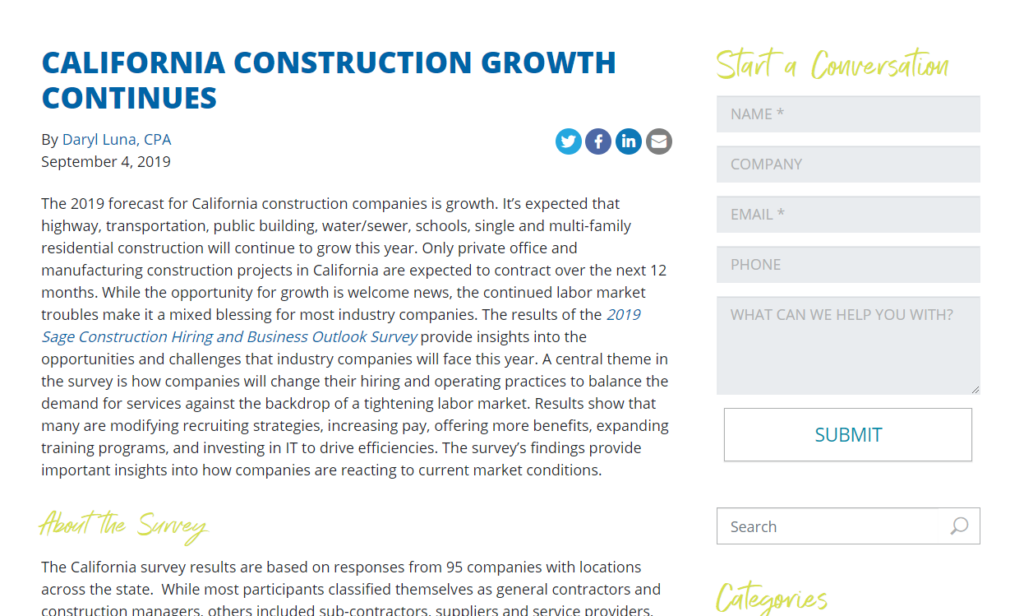SEO Guides, Tips & More!
Learn from Our Experience
Turn Your Website into a Lean, Mean Lead-Generating Machine
For professional service firms, including marketers, the opportunity to redesign the company website is exciting. It offers the opportunity to make visual changes (new fonts, brand colors, imagery, and even video) while incorporating brand-driven themes and messages. The end goal is a website that speaks to prospect and customer needs while piquing their interest in the services offered and unique insights and expertise around each.
Making it easy to move a prospect through the sales cycle and convert them into an active lead is essential while ensuring there are the proper tools and functionality available to encourage engagement with calls to actions, gated content, and even interactive tools. Whether a firm has a robust website with various conversions or is just started, there are some important and immediate steps to take which can make the website more efficient for lead generation.
Remember, these are tips that come from my years of experience working with accounting, law and other professional service firms. Some are ones I have learned while others are nuggets of wisdom shared within various discussions. I’m hopeful one or more of these will resonate with your efforts.
- Messaging –Don’t make the mistake of talking about the firm/company in all the website copy. Websites that talk only about the firm’s services and experience level totally miss the boat when it comes to engaging prospects. While they may want some information on that topic, they are far more interested in learning how the firm will solve their issue or problem. It doesn’t matter if the partner group has a combined 100 years of experience if they can’t solve the prospect’s problem. Review and refine messaging to speak to the needs and issues of prospects.
If the firm has multiple prospect types, then make the space to speak to their various needs in appropriate places on the website. No prospect will ever buy a service because a firm has been in business for 100 years (or some other random number). There needs to be an emotionally compelling reason, and it’s up to the website content to paint the right picture – with words – for visitors.
- Partner Emails – It’s normal when redesigning a website to want to include partner emails and other contact information. In fact, it’s often expected that the marketing department includes this information on relevant service and industry pages. However, it’s important to recognize that simply including their email and not ensuring marketing is alerted when a lead is generated creates a challenging situation. Why? There are several reasons, including:
- Tracking – It’s impossible for marketing to track leads coming in through the website if they are not alerted. Since the website and its performance typically are marketing’s responsibility, it makes sense there should be some way to track opportunities.
- Follow Up – When marketing is not included in new opportunities, it makes timely follow up almost impossible. While some firms have “rockstar” partners who follow up with every lead as soon as it crosses their desk, others have the opposite. That’s why marketing needs to be included in the follow-up process. At a minimum, marketing should be aware when follow up has occurred, the result and next steps. In many firms, marketing will be responsible for sending an immediate reply when a partner is off-site, out of the office or otherwise unavailable. Since we live in a world of immediate gratification, the sooner the reply the better the chance a qualified lead will become a client.
- Spam – Many partners and marketers complain partners experience a high level of “spam” emails after a new site launches. If an email address is included within the HTML of a page, it can easily be “scraped” by a spider and added to any number of databases for future activity. Preventing spammy type emails from making it to the partner’s inbox should be an important consideration. The last thing anyone wants is a beautiful website that results in headaches and nonsense for leadership.
One effective way to prevent these issues is to direct inquiries to partners through a contact form. This allows marketing to have a record of all inquiries made while sending the partner a copy of the communication. If the partner group will not permit this format, then ensure a marketing email address such as communications@sample.com is cc’d so there is a duplicate record of the communication initiated.
The same principle can apply to direct dial numbers. Consider using a Google special tracking number or general office number in place of direct dials to allow for a better understanding of lead activity and reduce the amount of sales calls.
- Contact Form – One mistake many make is including the firm’s address(es) on the same page as the “Contact Us” form. Although it may make sense to do this, it makes reporting more difficult because assumptions about user intent cannot be made. When looking at the number of users who visited the “Contact Us” page (assuming the address information is located there), it’s impossible to know how many were leads that failed to convert versus those who simply were looking for the office address.
There is a distinct difference in user intent, and a savvy marketer will want to know the difference. It’s important to have only the contact form (or other means of connection) on the “Contact Us” page. Move the address(es) to a child page and make it easier for visitors to find the information. This will go a long way to ensure the number of visitors to the “Contact Us” page is looking to connect and not for other information.
- Blog Post Layout – Many marketers and business owners make the mistake of believing each user will come to content in the same way. Typically, the assumption is they will come to the homepage, review the content and select what other parts of the website to view. As an SEO strategy matures and blog content evolves, this is more often than not an invalid assumption. For example, if you search a question in Google, it will point you to a page on a website that offers the best answer. What is the 80/20 rule? While many firms offer 401(k) audits, it’s unlikely the answer to this question is covered on the home or even service page. It most likely will be covered in the thought leadership section. For this reason, it’s important to carefully consider the layout of the blog page. A few recommendations to consider:
- Short Contact Form – Ensure there is a short contact form near or at the top of the blog post, perhaps in the left or right margin. If someone is interested in the topic, make it easy for them to reach out to you. Don’t make it difficult for a prospect to connect with the firm. (This is where I could talk about a comprehensive call to action, but I assume most will understand the two are compatibles in this instance.)
- Related Insights – It stands to reason that if a visitor is looking for information on a topic, they will want to see additional related insights. Consider adding a list of related insights (typically organized by category) to make it easy to share other insights and thought leadership from the firm. Remember, once you have them interested, you want to keep them connecting with the firm.
- Featured Service – Also consider dedicating some real estate to a featured service. This is where a marketer can connect the dots for the prospect between the topic under research and the actual service the firm offers. . Not everyone will want to purchase a service, but it’s imperative it’s easy for them to find the information should they want it. Again, don’t make it difficult for someone to buy from your firm.

In my experience, the blog post page is the second most important page on a site behind the homepage. Making these small changes will help to increase time on site and visitor engagement, which will – hopefully – lead to more conversions.
Your Thoughts?
There is certainly more I can share, but I’m curious to hear your thoughts. Did we miss something? What best practices have been effective for you? Leave your feedback in the comment section below so we can all benefit from your experience.

